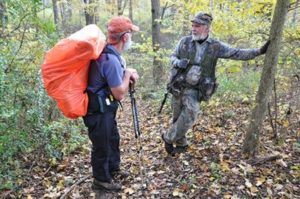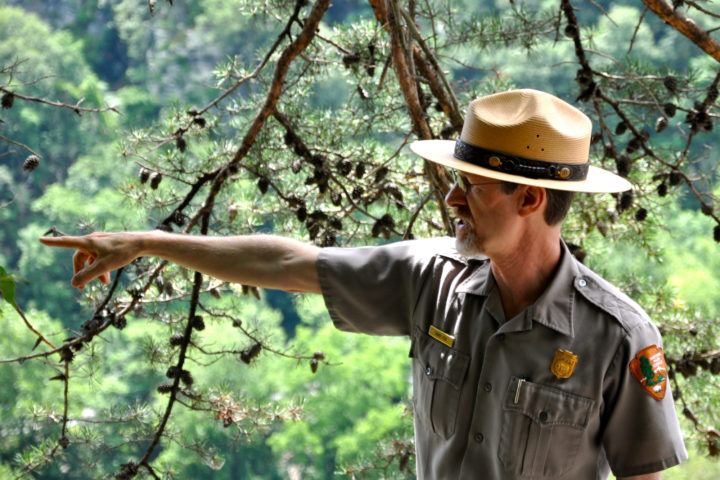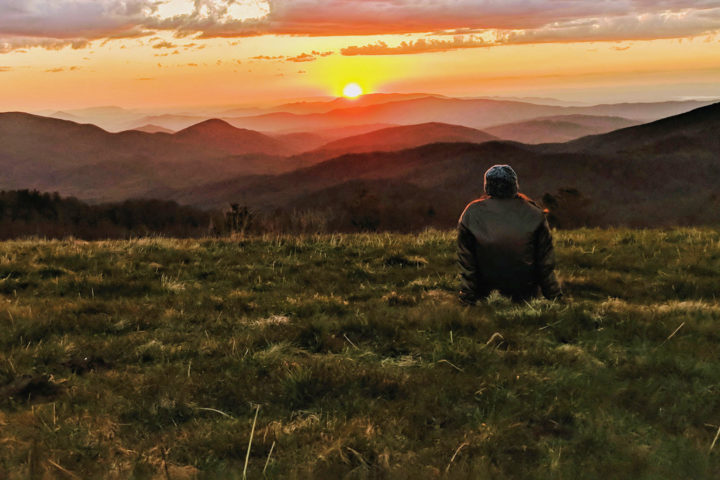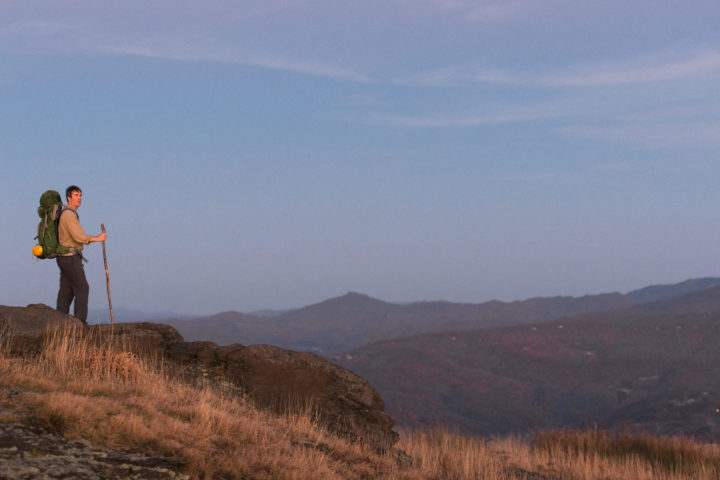Learn More
Hunting
Helpful tips for hikers and hunters during big game seasons on Appalachian Trail lands.
 The Appalachian Trail (A.T.) traverses many different types of public lands, including parks, forests, refuges, and game lands. It is not always easy while on the footpath to know which jurisdiction you are walking through, except at boundary signs. A concerted effort is made to identify land types on official A.T. maps, but hikers and hunters are advised to “know before you go.”
The Appalachian Trail (A.T.) traverses many different types of public lands, including parks, forests, refuges, and game lands. It is not always easy while on the footpath to know which jurisdiction you are walking through, except at boundary signs. A concerted effort is made to identify land types on official A.T. maps, but hikers and hunters are advised to “know before you go.”
Hunting is permitted along approximately 1,250 miles of the A.T. through national forest lands, national recreation areas, and state forests and game lands.
Hunting is prohibited along approximately 900 miles of the Trail through national parks (like Shenandoah and the Great Smoky Mountains), most state parks, and on lands acquired by the National Park Service exclusively for the Trail and still under National Park Service administration, including the outside edges by A.T. corridor boundary signs.
Hikers should be aware that the protected corridor is often narrow, averaging about 1,000 feet wide. Even in areas where hunting is prohibited, hunters on adjacent lands may not know that they are near the Trail. Hunters may inadvertently cross onto Trail lands or unknowingly fire toward the Trail.
Tips for Hikers During Hunting Seasons
Know Before You Go
Specific dates for hunting seasons vary year to year and also by type of game hunted and weapon used. Small-game seasons (turkey, rabbit) stretch from fall through the end of May; big-game seasons (deer, bear, moose) generally occur from October through January. In Loudoun County, Virginia, deer season extends through March. Learn the regulations and hunting seasons for the areas where you will be hiking before you go. Hunting on Sundays is prohibited in some states, but be aware that hunting is now allowed in Pennsylvania on some Sundays, including the Sunday after Thanksgiving.
Wear Blaze Orange
 Wear a fluorescent or “blaze” orange hat and vest (and pack cover if backpacking), or hooded outerwear when hiking in fall, winter, or spring. Blaze orange will help distinguish you from wild game. If you hike with a dog, your pup should also wear blaze orange visible from all sides. We recommend that pets be leashed at all times while hiking.
Wear a fluorescent or “blaze” orange hat and vest (and pack cover if backpacking), or hooded outerwear when hiking in fall, winter, or spring. Blaze orange will help distinguish you from wild game. If you hike with a dog, your pup should also wear blaze orange visible from all sides. We recommend that pets be leashed at all times while hiking.
A special note about Pennsylvania: On state game lands in Pennsylvania, all hunters and non-hunters are required to wear at least 250 square inches of fluorescent orange material on the head, chest, and back combined, or a fluorescent orange hat, from Nov. 15 to Dec. 15. The orange material must be visible from all angles (360 degrees).
A reversible fluorescent orange beanie featuring Appalachian Trail Conservancy branding may be purchased from ATC’s online Ultimate Trail Store or in the gift shop at ATC’s visitor center in Harpers Ferry, West Virginia.
Use Extra Caution at Dawn and Dusk
Hunting activity may increase at dawn and dusk when animals are feeding. Visibility is also poor. Avoid hiking during this time, or wear reflective vests and use a headlamp or flashlight for extra visibility.
Use Extra Caution Near Roads and in Valleys
Be especially cautious within 1/2 mile of road crossings (both approaching and leaving) and in valley areas.
Avoid Hunter Interference
Hikers should be aware that interference or harassment of hunters in the lawful pursuit of game is a violation of law in all 14 A.T. states. This includes interference or tampering with dogs used in the pursuit of game where allowed by law. Sportsmen are our partners in conservation, and encounters between hunters and hikers are opportunities to raise the awareness of both groups.
Deer Firearm Season
Deer firearm season is generally considered the most important time to exercise extra caution or consider hiking in an area where hunting is not allowed. Seasons vary by state. November is typically the prime month for deer firearm season, but October, November, December, and January are also months when deer firearm season may be open. During firearm season, if you want to choose an area of the A.T. where hunting is not allowed, you can hike in one of five national parks crossed by the A.T. (note that hunting is allowed in Delaware Gap National Recreation Area, another national park unit):
- C&O Canal National Historical Park, Maryland
- Harpers Ferry National Historical Park, West Virginia
- Shenandoah National Park, Virginia
- Blue Ridge Parkway, Virginia
- Great Smoky Mountains National Park, Tennessee and North Carolina
Hunting is also prohibited on Sundays in several A.T. states.
Be Heard
Make sure you are heard before you are seen by whistling, singing, or talking while you hike.
Tips for Hunters During Hunting Seasons
Follow All Hunting Regulations
- It is the responsibility of the sportsman to know where the land ownership and boundaries for the area where he or she wishes to hunt and to contact the landowner regarding the rules and regulations governing hunting at that location.
- The act of hunting and the discharging of weapons remains prohibited on National Park Service lands managed by the A.T. Park Office.
- The use of off-road vehicles, including ATVs, is prohibited along the entire length of the A.T.
Know Where the Trail Is
- A.T. maps can be purchased from the ATC and at local outfitters. Contact the nearest ATC office for more information.
- Do not shoot toward the Trail or the Trail corridor.
- A special note about Pennsylvania: Those hunting in Pennsylvania, where land hunting boundaries can be especially confusing, are encouraged to contact our Mid-Atlantic Regional Office for assistance in determining where hunting is permitted. The Trail is often located on the height of the land.
Be Sure of Your Target
- On National Forest lands in 2002 and 2003, two A.T. hikers were shot by hunters who thought they were shooting at deer. Both hikers suffered serious injuries, and both hunters were prosecuted.
Make Your Presence Known to Hikers
- Many hikers are from urban or suburban areas and are unfamiliar with hunting. Hikers may not be aware of hunting seasons, or that they are in or near areas open to hunting.
- Hikers may not be wearing blaze orange. Please use appropriate caution.
Hunting is Prohibited on Lands Acquired by the National Park Service for the Trail
- Be aware that, although the protected National Park Service Trail corridor is marked with yellow blazes and U.S. Boundary signs, corridor-boundary monitors cannot post (and maintain) signs every year along all of the more 1,200 miles of boundaries where hunters might cross onto A.T. lands.
- The Trail itself is marked by 2″ by 6″ vertical white rectangles painted on trees. Less familiar are the boundary blazes and signs on NPS corridor lands. Here, white 3″ x 12″ U.S. Boundary signs are placed facing out from the boundary with A.T. lands behind them. Trees on (or within a few feet of) the boundary are blazed with irregular yellow paint marks.
- Keep in mind that about 75 miles of the boundary of Pennsylvania State Game lands are marked with white paint, which occasionally causes confusion with white A.T. blazes.
Hunting Seasons on the Appalachian Trail
Note that hunting seasons are shown in ranges and may not be consecutively occurring dates. Not all dates apply to all counties or towns; hunting dates and laws (including, but not limited to, Sunday and nighttime hunting) are subject to change. Confirm hunting season dates locally before you go. This listing is not comprehensive.
Select a state to see the dates for each hunting season
Maine
Excluding Sundays
Fall Big Game: Late August – Late November
Spring Wild Turkey: Early May – Early June
For more information and other hunting seasons, contact:
Maine Department of Inland Fisheries and Wildlife
(207) 287-8000
www.maine.gov/ifw/
New Hampshire
Fall Big Game: Late August – Late September
Spring Wild Turkey: Late April – End of May
Small Game & Coyote: See link below
For more information and other hunting seasons, contact:
New Hampshire Fish and Game Department
(603) 271-3421
www.wildlife.state.nh.us
Vermont
Fall Big Game: Early October – Mid December
Spring Wild Turkey: Late April – End of May
For more information and other hunting seasons, contact:
Vermont Fish and Wildlife Department
(802) 828-1000
www.vtfishandwildlife.com/
Massachusetts
Excluding Sundays
Fall Big Game: Mid September – Late January
Spring Wild Turkey: Late April – Late May
For more information and other hunting seasons, contact:
Massachusetts Department of Fisheries and Wildlife
(508) 389-6300
www.mass.gov/eea/agencies/dfg/dfw/
Connecticut
Excluding Sundays
Fall Big Game: Mid September – Late January
Spring Wild Turkey: Late April – Late May
For more information and other hunting seasons, contact:
Connecticut Department of Energy & Environmental Protection
(860) 424-3000
www.ct.gov/dep
New York
Fall Big Game: Early September – Mid December
Spring Wild Turkey: Late April – End of May
For more information and other hunting seasons, contact:
New York State Department of Environmental Conservation
(518) 402-8883
www.dec.ny.gov/outdoor/hunting.html
New Jersey
Excluding Sundays except state wildlife management areas and private property
Fall Big Game: Early September – Late January
Spring Wild Turkey: Late April – Late May
For more information and other hunting seasons, contact:
New Jersey Division of Fish and Wildlife
(609) 292-2965
www.state.nj.us/dep/fgw/
Pennsylvania
Excluding most Sundays except special dates listed with PA Game Commission
**IMPORTANT** On state game lands in Pennsylvania, all hunters and non-hunters are required to wear at least 250 square inches of fluorescent orange material on the head, chest, and back combined, from Nov. 15 to Dec. 15 (except on Sundays). The orange material must be visible from all angles (360 degrees).
Fall Big Game: Mid September – Late January
Spring Wild Turkey: Late April – Late May
For more information and other hunting seasons, contact:
Pennsylvania Game Commission
(717) 787-4250
www.pgc.state.pa.us
Maryland
Fall Big Game: Mid September – Late January
Spring Wild Turkey: Mid April – Late May
For more information and other hunting seasons, contact:
Maryland Department of Natural Resources
(877) 620-8367
www.dnr.state.md.us/huntersguide
West Virginia
Hunting is allowed on Sunday in Jefferson County private lands that border A.T. corridor.
**IMPORTANT** Since the A.T. traverses both West Virginia and Virginia in some sections, hikers should be familiar with hunting season information in both states.
Fall Big Game: Late September – Early February
Spring Wild Turkey: Mid April – Late May
For more information and other hunting seasons, contact:
West Virginia Division of Natural Resources
(304) 558-2754
www.wvdnr.gov/hunting/hunting_regs.shtm
Virginia
Excluding Sundays
**IMPORTANT** Since the A.T. traverses both Virginia and West Virginia in some sections, hikers should be familiar with hunting season information in both states.
Fall Big Game: Late September – Late March
Spring Wild Turkey: Early April – Mid May
For more information and other hunting seasons, contact:
Virginia Department of Game and Inland Fisheries
(804) 367-1000
www.dgif.virginia.gov/hunting/regulations
Tennessee
**IMPORTANT** Since the A.T. traverses both Tennessee and North Carolina in some sections, hikers should be familiar with hunting season information in both states.
Fall Big Game: Late August – Mid January
Spring Wild Turkey: Early April – Late May
For more information and other hunting seasons, contact:
Tennessee Wildlife Resources Agency
(615) 781-6500
www.tn.gov/twra/
North Carolina
**IMPORTANT** Since the A.T. traverses both North Carolina and Tennessee in some sections, hikers should be familiar with hunting season information in both states.
Fall Big Game: Mid September – Early January
Spring Wild Turkey: Early April – Late May
For more information and other hunting seasons, contact:
North Carolina Wildlife Resources Commission
(919) 707-0010
www.ncwildlife.org
Georgia
Fall Big Game: Mid September – Late January
Spring Wild Turkey: Late March – Mid May
For more information and other hunting seasons, contact:
Georgia Department of Natural Resources Wildlife Resources Division
(770) 918-6400
www.georgiawildlife.com/hunting
Discover More

Plan and Prepare
Safety Tips and Crime Prevention
While the Appalachian Trail is safer than most places, it is not immune from crime or insulated against the problems of the larger society.

Plan and Prepare
Hiker Resource Library
A collection of resources for hikers to stay safe, healthy, and responsible on the Appalachian Trail.

ATC's Official Blog
A.T. Footpath
Learn more about ATC's work and the community of dreamers and doers protecting and celebrating the Appalachian Trail.
